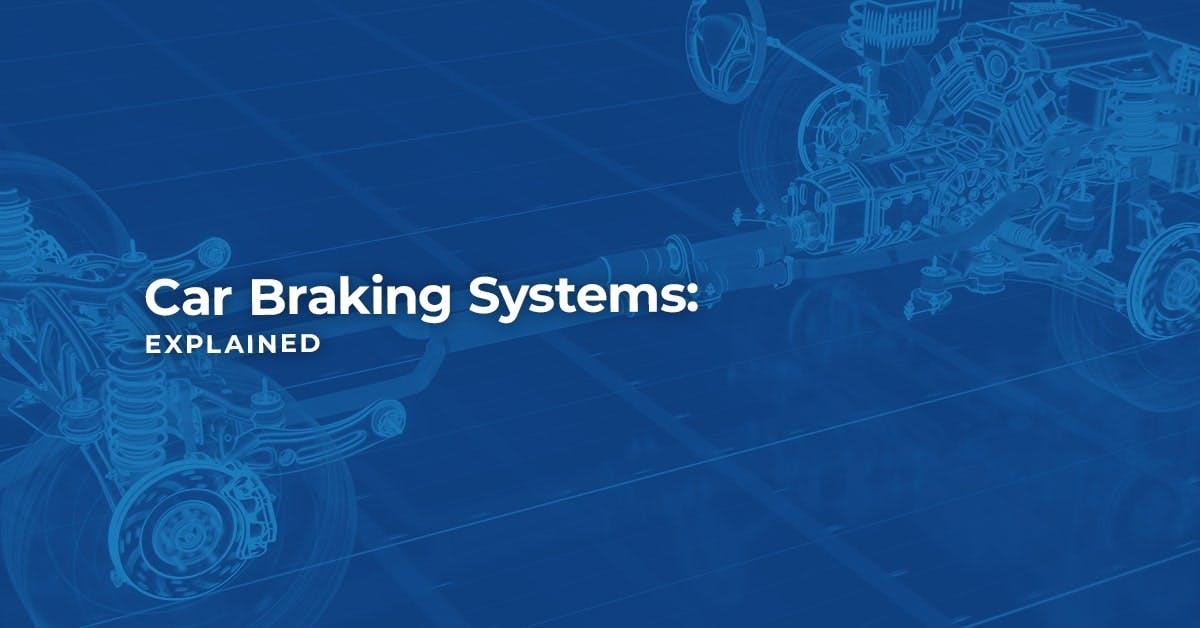Whilst all brakes are designed to slow down or stop a vehicle, different car braking systems create the friction needed to do so in various ways.
Your vehicle’s braking system is made up of a number of key components which are connected by brake hoses and brake pipes. The two most common forms of brake assembly are disc brakes and drum brakes, and many modern cars are fitted with anti-lock brakes as standard.
Read on to find out how these braking systems work, and why it is so important that you take good care of your brakes.
Page Contents
Disc Brakes
Most cars are fitted with disc brakes as standard, though some cars use drum brakes at the rear. Disc brakes are located on the front axle of most modern vehicles.
In a modern braking system, a vehicle will have brake calipers, brake discs, and brake pads. When the brake pedal is applied, the calipers push the brake pads against the rotating brake disc. This action generates friction which allows the vehicle to slow down or stop.
Most modern vehicles have a set of brake calipers for each wheel, which may be referred to as a dual-piston or four-piston set-up. There will be a caliper on both the driver and passenger side of the front and rear wheels.
Disc brakes are usually made of cast iron, but can be made from carbon or ceramic composites.
It is dangerous to drive with damaged disc brakes, as this can reduce braking performance and put yourself and other drivers at risk on the road.
You may need to replace your disc brakes or a related component if you notice any of the following warning signs:
- Warped brake disc
- A grinding noise when braking
- Reduced brake performance
- The brake pedal is less responsive
- The steering wheel wobbles when driving
That being said, it is often easier to tell when the brake pads need to be replaced. In any case, it is important that you have your brakes looked at by a professional mechanic if you suspect they have worn out.
Drum Brakes
A drum brake system features hydraulic wheel cylinders, brake shoes and a brake drum. When the brake pedal is pressed, the two brake shoes are forced against the inner side of the brake drum by the hydraulic wheel cylinders. This friction causes kinetic energy to be transferred into heat energy, which helps the car to slow down or stop.
Whilst drum brakes are cheaper to produce than disc brakes, they are becoming less common in traditional petrol and diesel vehicles, as they are less effective at dissipating heat and get very hot under frequent braking.
Drum brakes tend to be used for rear wheel brakes.
Brake Pads
Brake pads are attached to each side of the brake caliper. When you apply the brake pedal, hydraulic pressure is generated in the brake system which is then transmitted to the brake calipers. The caliper pistons push the brake pads against the brake disc, creating friction between the pads and the disc.
Brake pads are a feature of both brake disc and brake drum systems, and are sometimes referred to as ‘shoes’.
Brake pads can be organic, ceramic, semi-metallic or fully metallic - each material is designed to absorb heat.
Organic brake pads are quiet and do not need to be changed as frequently, as they do not wear down the disc.
Similarly, ceramic brake pads are quiet, long-lasting and have a better braking capacity than organic brake pads.
Semi-metallic pads have an even better braking capacity, but they wear the discs down more.
Full-metal brake pads are often a feature of race cars, and have an excellent stopping capacity. However, they are noisy, and will wear the brake disc down the most.
Anti-lock Brakes (ABS)
An anti-lock braking system - also known as ABS - will help the driver steer in emergencies by restoring traction to the tyres and reducing the likelihood of skidding. Anti-lock brakes kick in when braking sharply and are most effective on dry roads.
In an anti-lock braking system, speed sensors can detect ‘locking’ and will notice when a wheel stops moving. Your car’s wheels can lock up if you apply the wheels too quickly, meaning that the wheel won’t turn and the vehicle may skid.
In an ABS, valves control and relieve the pressure in the brake lines, and a pump can increase the pressure when needed. The valves and speed sensors are controlled by a computer known as a controller.
Anti-lock brakes give you more control over your vehicle when braking at high speeds, automatically applying and releasing the brakes multiple times a second if needed. This is especially useful for drivers travelling in wet weather, where there is an increased chance of aquaplaning.
The Importance of Your Car's Braking System
Whether your car uses a disc brake, drum brake or anti-lock braking system, it is incredibly important that you take good care of your brakes.
As the most vital safety feature in your vehicle, your car’s brakes can help you to stop your vehicle in an emergency and avoid collisions with other vehicles or pedestrians.
Without regular maintenance, a fault with the braking system could occur suddenly, and cause the driver to lose control of the vehicle. That’s why it is so important that you take good care of your car’s brakes, by booking a brake pad or disc replacement at the first sign of trouble.






